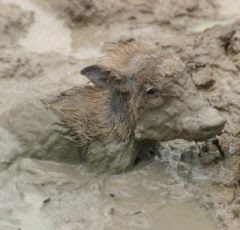The 20-inch 'Pegasus' pipeline that ruptured late Friday in the middle of a subdivision near Mayflower,Arkansas and Lake Conway, a popular recreational and fishing area, was carrying dilbit - a mixture of tar sands crud and solvents needed to make the crap pump-able. Exxon itself estimated today that the spill over 10,000 barrels [420,000 gallons] and the U.S. Environmental Protection Agency is categorizing as a 'major spill'.
The Exxon Pegasus pipeline was built for normal crude oil, not for bitumen. Bitumen is not crude oil. It is a mix of bitumen, (think asphalt) extracted from tar sands and solvents to make it sufficiently liquid to flow. The huge difference in pressure and heat required to force bitumen through pipelines means it's only a matter of time before they are worn away by the sand, rocks and grit embedded in the mixture. The mixture files grooves into the pipe metal or other material. When one section bursts and eventually that section is replaced, there are near and distant sections ready to burst as soon as the flow and pressure is resumed. Dilbit has no business going through a pipeline built for crude oil.
Dilbit doesn't small like oil and it definitely it doesn't clean up like oil as the 2010 spill in Kalamazoo, Michigan showed. Immediately upon contact with air the solvents that dilute the bitumen (the diluants) evaporate off much of the dilbit leaving the heavy goo to sink. After 2 years of work and almost $1,000,000,000, the mess still isn't cleaned up. Though hundreds of emergency workers are doing everything they can in Arkansas 24/7 to keep Conway Lake safe we all know shit runs downhill and 422,000 gallons is a lotta shit.
The heavy tar sands crud is a huge long-term danger to aquatic life and water safety but the approximately 30% that is 'dilutent' posses and even greater immediate threat to every living thing as it evaporates. The silence about the ingredients of the diluent is no mystery. The oil industry says the formulas are a trade secret but sources, including crudemoniter.ca, offer a dangerous and deadly list of the most common components of every solvent the industry likes to not talk about. There's the aromatics toluene, benzene, xylenes, ethylbenzenecy, clohexane and other naphthenes all known carcenogens. There's hydrogen sulfide (H2S) and thiols, traditionally also called mercaptans, all very toxic as well. Plus others not publicly published by science researchers.
Twenty-two homes were immediately evacuated in the subdivision near Mayflower not because of the crud itself but because of the dangerous evaporating diluents in the air. By today Exxon and Enbridge have almost as many Public Relations propaganda artists spinning this story as Arkansas has cleanup workers on the job. Hopefully folks will see through the smokescreen of industry bullshit, but if the past is any predictor of the future...



